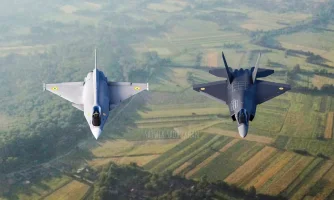- Views: 3K
- Replies: 15
In a significant move to enhance its underwater combat capabilities, India has officially commenced the construction of its largest and most sophisticated autonomous submarine.
The project is part of a broader strategy to develop a fleet of large unmanned underwater vehicles (UUVs) to safeguard its maritime interests, particularly in response to China's increasing activities in the Indian Ocean Region (IOR).
Krishna Defence and Allied Industries Ltd (KDAIL) marked the start of this initiative with a formal plate-cutting ceremony for the 'Jalkapi' Extra-Large Unmanned Underwater Vehicle (XLUUV) at its Gujarat facility on June 10, 2025.
The event, attended by senior Indian Navy officials, highlights a major step forward in the nation's 'Atmanirbhar Bharat' (Self-reliant India) policy, which promotes domestic production in the defence sector.
This initial 20-ton vessel is viewed as a stepping stone towards a more ambitious 100-ton unmanned submarine currently being planned by the Defence Research and Development Organisation (DRDO).
The Jalkapi, which translates to 'Mermaid', is a 20-ton autonomous platform developed by the Indian Navy's own design bureau. Engineered for stealth, the 11-meter-long vehicle is capable of operating at depths of up to 300 meters for extended periods of 30 to 45 days without needing to surface.
Its advanced sensor package, including sonar arrays, high-definition cameras, and environmental sensors, will allow it to conduct a wide range of missions such as intelligence gathering, surveillance, anti-submarine warfare, and mapping of the seabed.
Its capabilities are comparable to leading global systems like Boeing’s Orca XLUUV.
Looking further ahead, the DRDO is conceptualising a far larger 100-ton XLUUV. This future platform, approved in 2024 with a budget of approximately ₹2,500 crore (over $290 million), is designed to be a formidable presence underwater.
Plans indicate a 16-meter-long vessel capable of carrying up to 10 tons of external payload, which could potentially include torpedoes and mine-laying systems.
Once built, this massive unmanned submarine would be in the same class as advanced international platforms developed by the US, Germany, and Russia.
The technical specifications for the proposed 100-ton submarine are ambitious, aiming for an endurance of over 45 days powered by an advanced Air Independent Propulsion (AIP) system.
It is expected to cruise at over 4 knots (7.4 km/h) and reach top speeds of at least 8 knots (14.8 km/h). The design incorporates a comprehensive sensor suite, including towed and flank array sonars, making it highly effective in both deep and shallow coastal waters.
Its operational flexibility will be enhanced by its ability to be deployed from ports, larger 'motherships', or even land-based launchers.
The push for these advanced unmanned systems is strategically driven by the need to fill critical capability gaps and counter regional threats.
The Indian Navy currently operates around 13 conventional submarines, well short of its goal of 24 by 2030, due to delays in procurement programs like Project-75I.
Unmanned vehicles like the Jalkapi can supplement the manned fleet, undertaking long and high-risk surveillance and patrol missions. This strategy is particularly aimed at monitoring the growing deployment of Chinese naval assets, including UUVs, which have been detected in the Indian Ocean in recent years.
This new direction is aligned with the Indian Navy's "Integrated Unmanned Roadmap for 2021–2030," which prioritises the induction of autonomous systems to bolster maritime security.
The development of the 100-ton XLUUV, with a prototype expected by 2027, will involve major domestic shipbuilders such as Mazagon Dock Shipbuilders Limited (MDL) and Larsen & Toubro (L&T).
Beyond strengthening national defence, success in this field could also position India as a key exporter of advanced defence technology, contributing to its goal of achieving $6 billion in defence exports by 2029.


